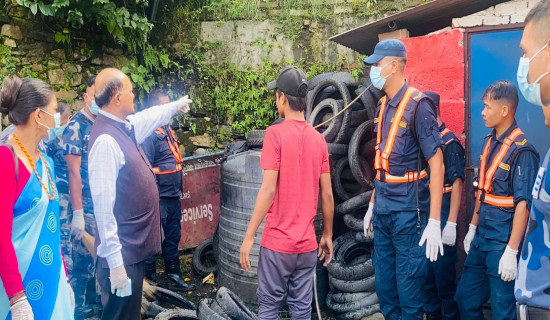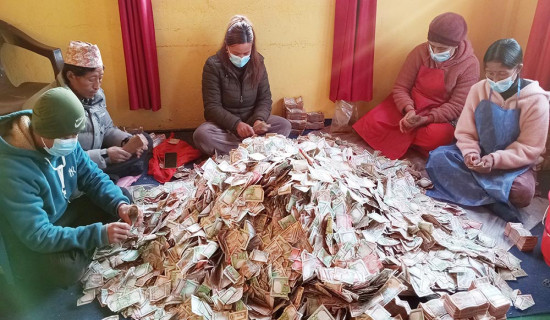- Thursday, 18 September 2025
Pangolin Conservation In Nepal
The pangolin, the most trafficked mammal in the world with a size ranging from 30 cm to 1.8m is completely covered with scales made up of keratin. About one-fourth to one-third of the total weight of the species is due to its skin and scale. These scales are modified for defensive purposes.
They are solitary and rarely interact with each other besides the courting and mating period. Talking about their structure, they not only have defensive scales, but thick eyelids along with constrictable ears and nostrils also protect them from the ant and termites entering it. The long and sticky tongue helps them to catch their prey. Similarly, teeth are absent in them, instead, they have muscular stomachs lined with keratinous spines that assist them in breaking the prey they ingest. Their claws are modified for digging. There is a huge size difference between males and females, i.e males are about 50% heavier than females.
There are eight species of pangolin found worldwide, four of them in Asia and four in Africa which are classified as globally threatened (IUCN, 2017) also listed in Appendix 1 of the Convention on International Trade in Endangered Species of Wild Flora and Fauna (CITES, 2071). Among the eight species, two species are found in Nepal, the critically endangered Chinese pangolin (Manis pentadacryla) (Challender et al., 2019) and the Endangered Indian pangolin(Manis crassicaudata) (Jnawali et al.,2011; Mohmood et al., 2019). Chinese pangolin ranks 17th and the Indian pangolin ranks 86th EDGE (Evolutionary Distinct and Globally Endangered) mammals with low to medium conservation attention afforded to them.
Distinct Appearance
Though it is difficult to distinguish between Chinese and Indian pangolins just by the sighting, they are different in their physical appearance. Chinese pangolins are about 40-50cm long and weigh 9kg with a small, narrow mouth and a little, pointed head whereas Indian Pangolin is 84-122cm in length and 10-16kg in mass.
In Nepal, Pangolin is commonly known by the name Saalak whereas people of different localities and communities have given it a separate name. The people of Terai call them by the name Hile Machha OR Saal Machhari, the Tamang community by Kose, the Newar community by Kayanaya, the Limbu community by Padasekh, the Kirat community by the name Pikichi and people in the Hilly area of Western Nepal call them Bhakunde Bhoot. Also in Lamjung district, they are known by the name Pakhe Machha.
According to a report published by DNPWC in 2019, pangolin occurs in different landscapes such as Riverine forest, Sal forest, Mix hardwood forest, grassland and agricultural lands with altitude variations ranging from Terai plain foothill up to 2000 m in the central and eastern regions to the lowland and foothill of Siwalik (Churia) in the west range. They are found in the forest having Shorea robusta, Schima wallichii, Castanopsis indica, and Alnus nepalensis as dominant tree species. They prefer forests with a medium canopy cover (50-70%) rather than dense and sparse forests. In Nepal, they are found in 61 districts (Suwal et al.,2020). Similarly, Chinese pangolins are dominantly found in the central to eastern mid-hill of Nepal whereas Indian pangolins are documented in the western plain (DNPWC, 2019). Chinese pangolins are reported from 24 districts in Eastern (Saptari, Jhapa, Illam, Dhankuta, Panchthar, Khotang, Terathum, Khotang,
Taplejung, Sankhuwasabha and Solukhumbu), Central (Makwanpur, Sindhuli, Ramechhap, Bhaktapur, Kathmandu, Lalitpur, Kavrepalanchowk, Dhadang, Dolakha and Sindhupalanchowk) and Western (Palpa, Lamjung, Gorkha and Baglung) part of the country, Indian pangolins from 2 districts (Bara and Kailali) and both species of pangolin are found on 6 districts (Chitwan, Parsa, Banke, Bardiya, Kanchanpur and Surkhet). Similarly, 29 districts contain either one or both of the species (Suwal et al., 2020). The estimated habitat of the pangolin is 22,393 km2 among which only about 2940 km2 are contained inside protected areas (Suwal et al., 2020).
Most Trafficked
As Pangolin are the most trafficked mammals, they are mostly hunted for their flesh. Despite any scientific evidence, people believe that pangolin flesh has medicinal value. Different superstitious beliefs give rise to this trafficking. In the Tamang community, pangolin uterus extract is given to pregnant women in the belief of protecting them from abortion hazards and their scales are considered as an ornament (kotwal et al., 2015). As pangolins are anteaters, people believe that having a piece of scale at their home avoids ant invasions. Their scales are believed to be a symbol of good luck, whereas sighting them is taken as bad luck. So in such cases, people immediately kill them.
At present, they are trafficked for money as they have a high monetary value. Their small body size and wide habitat distribution including human-modified landscape and their behaviour of suddenly stopping and curling up into a ball if threatened, made them easy to catch, which is also the prominent reason for spreading pangolin trafficking (Wu et al., 2020).
Illegal trade of pangolin is reported from 18 districts of Nepal namely Kathmandu (where more than half occurred), Dolakha, Bhaktapur, Illam, Makwanpur, Nuwakot, Sankhuwasbha, Banke, Chitwan, Dhading, Jhapa, Kaski, Kavrepalanchok, Lalitpur, Panchthar, Rupandahi, Sindhupalchok and Sunsari (Bashyal and Shrestha, 2021). After observing the trade network of smugglers, it is found that pangolin and its derivatives were smuggled from the eastern, western and central regions of Nepal to Kathmandu and from Kathmandu to different parts of the world. According to the research, three potential modes of pangolin trade were found to occur;
From the area of poaching to Kathmandu where it is transported to the international market via air through the only international airport.
From the area of poaching to Kathmandu where it is transported to china via road.
From the area of poaching to Nepal-India and Nepal-China trade points.
Kathmandu is the major hub for these illegal trades (Paudel et al., 2020). Because of the international airport and easily accessible transportation to every part of the country as well as to china trade point (Tatopani and Rasuwagadhi), Kathmandu acts as the hub zone. Districts bordering China as well as India are also the major trade point for this illegal trade. Open borders, permit ease, the strong network between smugglers, weak policies, poorly equipped anti-poaching units and the involvement of high-profile persons are some of the reasons for the rising pangolin trade in Nepal.
There is a high involvement of males (98%) and Nepali nationals(99%) in such trafficking (Bashyal and Shrestha, 2021). The age range of convicts was 17 to 66 yrs. However, high involvement was that of 20-30 and 30-40 yrs old people.
The lack of employment opportunities and the high monetary value of trophies is the driving factor behind the involvement of such young people. Analysing convicts based on their caste and religion from 2015-2020, Tamang has higher involvement followed by Chhetri, Brahmin, Newar, Magar, Rai, Dalit, Tharu, Sherpa and others (Bashyal and Shrestha, 2021).
Both species of pangolins are protected under the national park and wildlife conservation act 1973. According to the NPWC Act 1973, possessing, selling and buying, transporting pangolins and their trophy are punished with a fine of Rs 500000 or imprisonment of 5-15 yrs.
Challenges and threats
In Nepal, hunting poaching and the illegal trade of pangolin are the major problems. People have taken it as a source of income and believe
it has medicinal value without any scientific evidence.
This is the reason for rising hunting and poaching. Loss of habitat due to forest encroachment, construction of infrastructures as a part of the development project and natural calamities such as floods, landslides, drought etc threatened its life.
Forest fire is also one of the serious threats. There is a lack of awareness in the individual and low priority for conservation is given at the government level. Limited institutions are working specifically on pangolin. And for the organisation working on the pangolin, there is no mutual coordination with the government. Also, insufficient budget allocation for the research and study of it. These are some of the challenges for pangolin and pangolin conservation.
Mitigation of these illegal trades is the only way to protect the species from extinction. High alertness at the border and airport, high security, strengthening the law, regular monitoring, and allowance of incentives and employment opportunities to the people are the possible way to mitigate illegal trade.
Individuals should be aware of the conservation status and importance. The government should improve its laws and policies. Budget allocation at the local and national levels for conservation practices is essential.
As there is very little research conducted, research grants should be given so that large information can be obtained. Thus, this creature has equal importance in ecosystem balance as others do. So its population must be secured.
(Kafle is a BSc student at the Institute of Forestry, Hetauda)

















